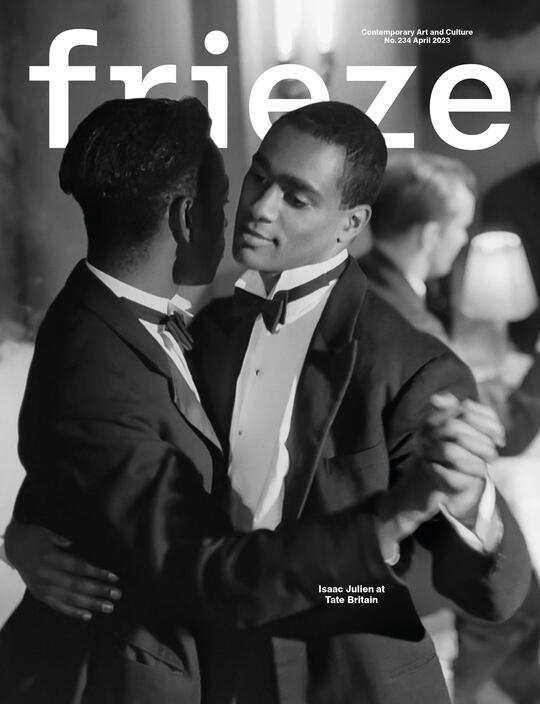Oh Suk Kuhn Studies Korean Architecture and Memory
The artist's photographic series documents remnants of Gwangju’s colonial legacies in buildings
The artist's photographic series documents remnants of Gwangju’s colonial legacies in buildings

When I first saw Oh Suk Kuhn’s photographic series ‘Enemy Property: Gwangju’ (2022–23), one image immediately caught my attention: pushed up against the left-hand wall of an apparently unremarkable interior was a dark wooden cabinet, identical to the one my parents had bought when they’d moved to a bigger home in Seoul in the early 1990s. In another work from the series, yellow vinyl flooring – popular in Korea between the 1960s and 1990s, due to its affordability and compatibility with the traditional underfloor heating system ondol and its resemblance to the high-end flooring of a traditional Korean house hanok – in an otherwise empty room provides a subtle hint that a Korean family once lived there. Instantly recognizable to anyone who lived in Korea during that era, these interior scenes capture images of the country’s recent past and act as a means of understanding a nation’s collective memory.

Born in the city of Incheon in 1979, Oh studied photography at Nottingham Trent University, before returning to his hometown to pursue a career in art. A significant port city serving the wider Seoul metropolitan area, Incheon acted as a gateway for Western culture in the late 19th century, and its development closely echoes South Korea’s modern geopolitical history. During Japanese occupation (1910–45) the city operated as a base; in 1950, it was where US and UN troops landed during the Korean War. Incheon witnessed both the light and shadow of industrialization from the 1960s to the 1980s, which manifested in the creation of industrial complexes and US military base towns. Over the past decade, Oh, who grew up surrounded by the remnants of this modernization, has sought to scrutinize the country’s complex evolution through its architectural legacies.
In his series of photographic triptychs ‘Chug (axis)’ (2016–ongoing), Oh juxtaposes buildings constructed in Daegu and Incheon by the Japanese during occupation, which were since repurposed by sex workers until the late 2010s, with the wounds left on the workers’ bodies, showing their lives under violence. In one triptych, near-abstract close-up shots of barbed wire dangling down an outer wall and crimson-tinted windows flank a cropped image of scarred flesh in a meditation on the buildings’ accumulated histories of oppression.

Oh continues his exploration of the legacies of occupation in ‘Enemy Property’ (2018–ongoing) by documenting jeoksangaok – the domestic residences built by the Japanese during the colonial period, which the Korean government, in tandem with the US army, sold to civilians following independence. The buildings have been modified in various ways over the past half century by their different owners. While tatami mats or other architectural elements of traditional Japanese homes remain, over the subsequent decades, generations of Koreans have accumulated their own life stories in these buildings through the addition of furniture, books, decoration and other modifications, adapting the original jeoksangaok to suit their own needs.
Having started by documenting buildings in his hometown, Oh has steadily broadened the scope of ‘Enemy Property’ by responding to where the work is exhibited. In 2021, the series was shown in an eponymous exhibition at Buyeon, a cultural space remodelled traditional Korean house, or hanok, in Incheon, curated by artist collective peach blossom and accompanied by performances from Japanese artist Yusuke Kamata and drawings by the architect Euijung Lee. Oh expanded the project further at the 2022 Busan Biennale by photographing jeoksangaok in Busan, another major port city.

For the upcoming Gwangju Biennale, the artist has continued to develop ‘Enemy Property’ by documenting jeoksangaok and other remnants of Gwangju’s colonial past. The series will be paired with his latest work which captures architectural embellishments engraved onto everyday structures, such as gates and walls, mostly in Gwangju. These elements – once a widespread trend in Korea, wishing for prosperity and blessings for its residents – were appropriated from art nouveau, mosques, and ancient Japanese and Chinese mythic, religious symbols. Reminiscent of Koreans’ practical adaptations of jeoksangaok, the ways in which these decorative features have evolved from their aesthetic origins also serve as a reminder of what the seemingly mundane buildings around us can tell us about a country’s past and present.
This article appeared in frieze issue 234 with the headline ‘Oh Suk Kuhn’.
Main image: Oh Suk Kuhn, The Text Book (Chulsoo and Younghee), 2006, digital c-print, 60 × 73 cm. Courtesy: the artist























